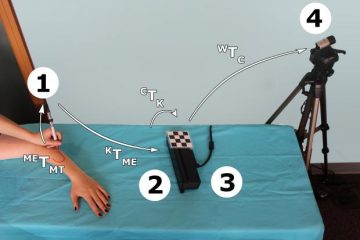
| Capstone Project: 3D Surgical Markings Using Intraoperative Navigation |
| Client: Dr. Rob Stead, Research Physicist, Novadaq Technologies Inc. |
| Student team: Prab Grewal, Sarah Holdijk, Rohit Singla, Kathy Xu |
| Professor: Purang Abolmaesumi |
Surgeons use a number of different techniques to help them visualize the body like ultrasound imaging or x-rays. They use these images to prepare for a surgery and also to help them navigate during a procedure. These visualization techniques present a two-dimensional picture, but the surgeon is moving in the three-dimensional space of the body. With current technology, surgeons look in two places to get the information they need – at the patient and at a monitor.
 This capstone project tracks the 3D surface of the surgical site and overlays marks made by surgeon prior to surgery onto a monitor image. The monitor might contain information such an infrared image showing the degree blood supply is compromised in areas surrounding wounds. By tracking a surgical marker in 3D space and reconstructing the surface of the scene, the prototype can overlay the marking made by the surgeon on the tissue surface onto the screen. The image above shows a coordinate system overview of how the prototype tracks and overlays a marker’s path. This technology would be particularly useful in improving patient outcomes in areas such as burn treatment, wound care and cosmetic surgery.
This capstone project tracks the 3D surface of the surgical site and overlays marks made by surgeon prior to surgery onto a monitor image. The monitor might contain information such an infrared image showing the degree blood supply is compromised in areas surrounding wounds. By tracking a surgical marker in 3D space and reconstructing the surface of the scene, the prototype can overlay the marking made by the surgeon on the tissue surface onto the screen. The image above shows a coordinate system overview of how the prototype tracks and overlays a marker’s path. This technology would be particularly useful in improving patient outcomes in areas such as burn treatment, wound care and cosmetic surgery.
The project allowed Novadaq Technologies to explore ways to apply 3D imaging and surgical navigation techniques in intra-operative imaging environments. The project was aimed primarily at developing Novadaq’s knowledge in algorithms and techniques in the area. The prototype answered questions and highlighted shortcomings of the technology that can be used to in future designs.
Along the way, the students gained insight into aspects of design development that do not exist in an academic project including clinical and regulatory constraints. They were excited to be working with a company. “I chose this capstone because it included a challenging range of requirements for the design, including hardware, computer vision, and a biomedical application. The client itself was a huge factor too – Dr. Stead’s presentation and Novadaq’s leadership in medical imaging were two factors that made me say, “I have to work with these guys”,” says Rohit Singla.
Rob Stead, our capstone client, had this to say about the student’s contribution to Novadaq, “I wanted to take advantage of the students’ knowledge and experience in areas outside of Novadaq’s main strengths. The project was something that allowed the team to explore their interests without being unnecessarily constrained by Novadaq’s existing products or technology. Having free reign to explore their ideas resulted in some fantastic work they can be very proud of, and will be something that can be applied in any number of imaging applications in the future.”

Prab Grewal, Sarah Holdijk, Kathy Xu, Rohit Singla
Find out more:
